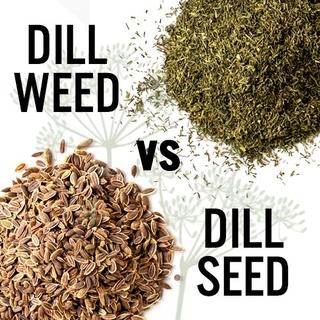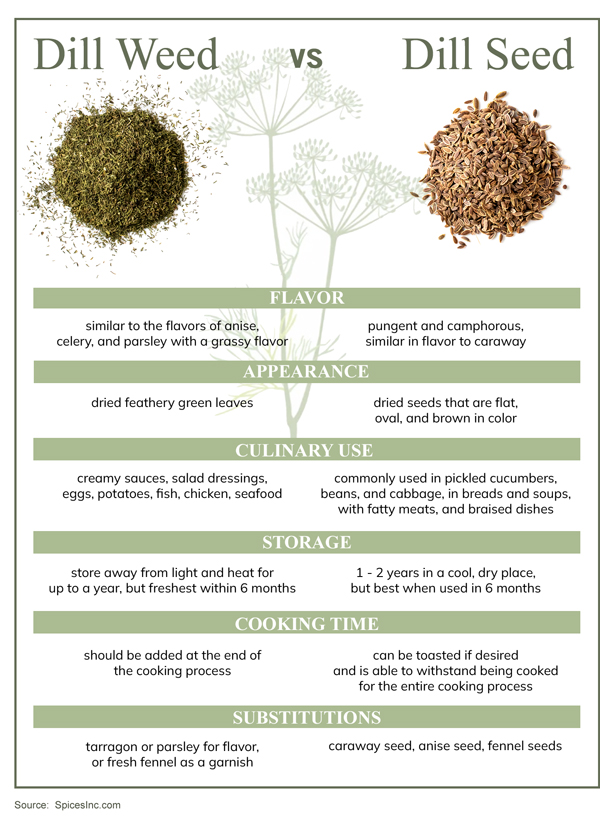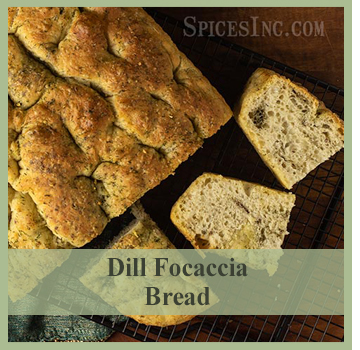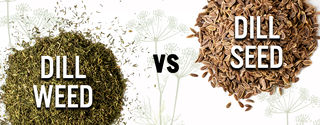Dill Weed vs Dill Seed

Dill Weed vs Dill Seed
Dill, Anethum graveolens, is an aromatic plant that is related to celery, carrots, and parsley. It is one of the small group of plants that produces both an herb from the feathery leaves, and a spice from the seeds. Though they are from the same plant the flavors are markedly different. Dill Weed, the leafy herb, tastes sweet and grassy with notes of licorice. Dill Seed, the crunchy little fruits of the plant, are pleasantly bitter and a touch camphorous. The flavor of the seeds offers a resemblance to anise or caraway seed.
What is Dill?
The fragrant dill plant loves sunny weather and a temperate climate, since it emerged along the shores of southern Europe and the Balkan states located near the eastern end of the Mediterranean Sea.
Though dill originated in a warm climate and has a delicate appearance, it is a hardy plant and can survive in temperatures as low as 25°F. It requires full sun to mature regardless of the temperature.
Because the Balkan states neighbor eastern Europe and dill has the capacity to still grow in colder weather, it has become a staple spice of cold-climate countries like Hungary, Poland, and Ukraine.
While the leaves and seeds of the dill plant have different flavors, they’re both aromatic and bold. Where the leaves are grassy and bright, the seeds are earthy and bitter. Dill is primarily associated with pickles in the US, but it does so much more. Both forms of dill go very well with bold flavors like mustard and garlic, but shine when they are allowed to take center stage on milder foods like potatoes or a creamy cheese.
Dill Weed
Dill Weed is an herb from the leaves of the dill plant. Whether they are dried or fresh these leaves have an airy quality; they are often described as feathers, fronds, ferns, or sprigs.
Conventional wisdom says that when you dry an herb, its flavor will concentrate and it will be more pungent than its fresh counterpart. Dill doesn’t play this concept straight. Fresh dill weed has a bold and grassy flavor with a sweep of licorice and hints of lemon. It’s characterized by the strength of its aroma as much as it is by the flavor in the leaves.
As it dries, dill weed becomes a bit more tame. The flavors do concentrate but the aroma becomes less pronounced; since the aroma is an important contributor to the effect this herb has on food it is perceived as less powerful. It loses a lot of its grassiness; licorice becomes the dominant flavor, and it develops a minty edge. You should still follow the standard dry-to-fresh conversion and use 1 teaspoon of dried dill weed for every 3 teaspoons (or 1 Tablespoon) of fresh dill. The licorice flavor can easily take over a dish if too much dried dill is added. And while there are some exceptions to this, dill weed, whether fresh or dried, should be added toward the end of cooking time. Prolonged heat will destroy the flavor-producing chemical compounds in this herb.
Substitutes for Dill Weed
If you need to substitute for dill weed, your first choice is tarragon. This gentle herb features the licorice flavor present in dill, though tarragon is much more mellow. It goes wonderfully with Mediterranean foods that feature dill, like fish dressed in lemon and olive oil or the spinach dish spanakopita, baked in flaky phyllo dough.
Another suitable substitute for dill weed is its cousin, parsley. Parsley shares the grassy qualities that dill has, though its underlying flavor leans more toward pepper than toward licorice. Use parsley as a substitute for dill in Eastern European favorites, like Hungarian mushroom soup, a Scandinavian mustard and dill sauce, or a creamy bowl of potato salad.
Fresh fennel leaves are also a good substitute for dill weed. They have the trademark licorice flavor, and it’s got the same feathery, light visual appeal. It makes a great garnish, and goes well in Italian salads or tossed over hummus or stirred into Persian-style basmati rice.
Dill Seed
The other way to make use of dill is by drying the seeds. Dill seeds, just 1/5 inch long, slender, and shaped like a tiny football, are technically a fruit. In order to use them as a spice, they should be dried and then ground, if desired.
Though it comes from the exact same plant as dill weed, dill seed has a different taste. It is rich and earthy with a pleasant, underlying bitterness and just a touch of the licorice-tinged grassiness of dill weed. If you work at dill seed, it can also produce a mellow sweetness that gives a nod to carrots, but that is not its upfront, identifying flavor.
Substitutes for Dill Seed
Caraway, anise, and fennel seeds are three straightforward substitutes for dill seed, and they are all related.
Caraway seeds are pungent and bold, with notes of camphor and just a spark of licorice.
Both anise and fennel seeds are valued for their licorice-like qualities, which is a secondary flavor in dill seed.
Caraway seeds can be used in a 1:1 ratio with dill seed; if you need a teaspoon of dill seed, a tablespoon of caraway will fit the bill nicely. Since anise and fennel have a more pronounced licorice flavor, you may want to use slightly less of them in a dish, depending on how you want your dish to taste when it is finished. All of these seeds can be toasted and either ground or used whole, and can stand up to prolonged cooking times.
Uses for Dill Seed and Dill Weed
 When we hear the word “dill” many of our thoughts turn to pickles. To make this staple of the American sandwich, choose dill seeds. Their flavors shine in the face of acidity and are terrific not just with pickling cucumbers but also with beets, peppers, and even eggs.
When we hear the word “dill” many of our thoughts turn to pickles. To make this staple of the American sandwich, choose dill seeds. Their flavors shine in the face of acidity and are terrific not just with pickling cucumbers but also with beets, peppers, and even eggs.
Dill seeds are delicious on bread or stirred into egg frittatas or quiches. They go well with hearty vegetables like cabbage, and are a natural complement to its relative, the carrot. Dill seeds also go well with meats and fish. They’re wonderful with lentils; no Indian daal would be complete without them. Dill seeds are a staple spice in a traditional corned beef spice blend.
Dill weed can also be used to create pickles through the process of fermentation. Fermentation doesn’t apply heat but rather, relies on a chemical reaction; since there’s no heat, the flavors of dill weed won’t get destroyed during cooking. It should be used mindfully and usually toward the end of cooking time. It is a natural companion for mild cheeses and, like the seeds, does well with a little acidity. This is why it pairs well with potato salad, whether it’s mixed with sour cream or vinegar, and why it makes a terrific mustard vinaigrette. Toss over lighter meats like fish or chicken, and add it to any vegetable you can imagine, since it will invariably brighten the flavor.
Dill weed and dill seed, both taken from the same plant, have significantly different flavors and play different roles in the kitchen. The leaves provide an herb that is airy and aromatic, while the seeds give earthy richness and depth. They are not able to be used interchangeably since they require different cooking methods to make the most of their qualities. Once you understand how to work with it, though, dill can provide an incredible spectrum of flavor to recipes from around the world.

